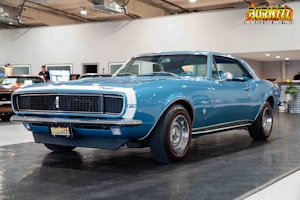Media | Articles
Point: Make Mine Restored
The first house we bought was a beautifully-preserved early 1900s structure that was the first house in our village to have indoor plumbing. The elderly lady who owned it before us was a fanatic about caring for things. When a workman came to do a repair, she wrapped plastic around the door knobs so no grease or dirt would get on them. She had the house remodeled in 1957. When we removed the old wallpaper the exact date the work had been done was penciled on the wall. The house looked exactly like it had looked in 1957.
When me moved into the house in the early ‘80s, we had four children ranging from a new baby to teenagers. We did the things families do in day-to-day living. We did not abuse the old house, but within a year it seemed to be falling apart. The dried out old wall-to-wall carpeting was quickly ruined. The wallpaper peeled. The brass coatings on the door knobs that the old lady had wrapped so many times, now made delicate by age, wore off in just normal use.
Looking back on the experience of owning that house makes it easy for me to put the story of the 1957 Plymouth buried in Tulsa in perspective. In fact, it is absolutely eerie that the old house had last been remodeled in the same year the Plymouth was built. It was almost if someone tried to protect both the building and the automobile from the ravages of time – and failed.
Angelo Van Bogart – the editor of Old Cars Weekly – is a fanatic about “survivor” type automobiles that have been preserved in their original condition. He owns a very nice 1955 Cadillac that is an absolutely wonderful example of a well-taken care of automobile. He also purchased a very low mileage mid-1980s Chevrolet Caprice on eBay and had it trailered from the East Coast to the Midwest so no miles would be added. Angelo doesn’t mind that the Caprice has the smaller V-6 engine, because he bought it to preserve it as an “original” car much more than to drive it. He has two other Caprice “Box Cars” to drive.
Considering Angelo’s proclivity towards “just-as-they-were” cars, his trip to see the 1957 Plymouth unearthed in Tulsa must have been an exciting adventure for him. As he started his pilgrimage to Oklahoma, there’s no doubt he envisioned a showroom-new Belvedere rising out of 50-year underground storage. And we’re sure he was extremely disappointed when he saw that the car had not survived in showroom-new condition. For Angelo, the pristine Plymouth that he envisioned leaving its tomb was “as good as it gets” in car collecting.
Marketplace
Buy and sell classics with confidence
But different people look at old cars differently and we tend to equate “survivor” cars with the old house we once owned. Our feeling is that a well-preserved car that is 40, 50, 60 or more years old is a wonderful artifact, but that it is going to start falling apart if you drive it regularly and put even a few thousand miles on it each year. We think that survivor cars that are a bit newer — say 20 or 30 years old — will last a bit longer in regular use, but the day will still come when their metal weakens, their plastic bends or the stitches in their upholstery start to come apart. With use, deterioration is inevitable and the older the car is, the more fragile the materials that make it up will be.
Since we enjoy driving our old cars as much as possible during the warm months, we actually prefer a well-restored car over a “survivor” car. Some folks take that to indicate a lack of appreciation for “original” cars, but that isn’t true. A car can be restored to original condition, in which case you wind up with a vehicle that is totally “stock,” but drives like new and provides dependable transportation.
The dependability of an old car is of utmost importance if you use the vehicle regularly. No one wants to struggle with a classic car that doesn’t run well or totally breaks down. Problem-prone cars are a great way to take the fun out of the hobby very quickly. With a car that “doesn’t make it,” you’ll miss the nostalgia and fun and wind up with hassles, repair bills and towing charges. In many cases, a broken down car can also be dangerous. Highway hazards from passing traffic to unwanted strangers could put you and your family in jeopardy.
Hobby purists will say that it is impossible to restore a car “just the way it came from the factory” and it’s hard to argue with that. But that doesn’t mean that a car is really a “modified” vehicle if it has different spark plugs or basecoat/clearcoat paint instead of nitro-cellulose lacquer. In all types of restoration work — buildings, artworks, antiques — certain concessions to modern restoration techniques have to be allowed for. Otherwise, history could not be properly preserved.
Many of the survivor cars that we see at shows had different style replacement parts added to them over the years, before they were detailed with reproduction parts that made them look original again. For example, a gas station that serviced the car may have added worm-gear style hose clamps which stayed on the vehicle until a hobbyist bought it and re-installed ring-type hose clamps. So now you see it at the show with OEM-style clamps, but they are not really original equipment — they are technically replacement parts.
In our book, cars — even old cars — were built to be used and the real fun of car collecting is driving these old timers. If you agree with this, a car that has been restored to run well and to look as original as possible is the type of vehicle that will give you the most hobby enjoyment. It is nice to visit car museums and see vehicles that look like the ’57 Plymouth in Tulsa would have looked if the time capsule had protected it properly, but you won’t want to drive a car like that very far unless you restore it first. Angelo probably won’t agree, but that’s my opinion.
John “Gunner” Gunnell is the automotive books editor at Krause Publications in Iola, Wis., and former editor of Old Cars Weekly and Old Cars Price Guide.









